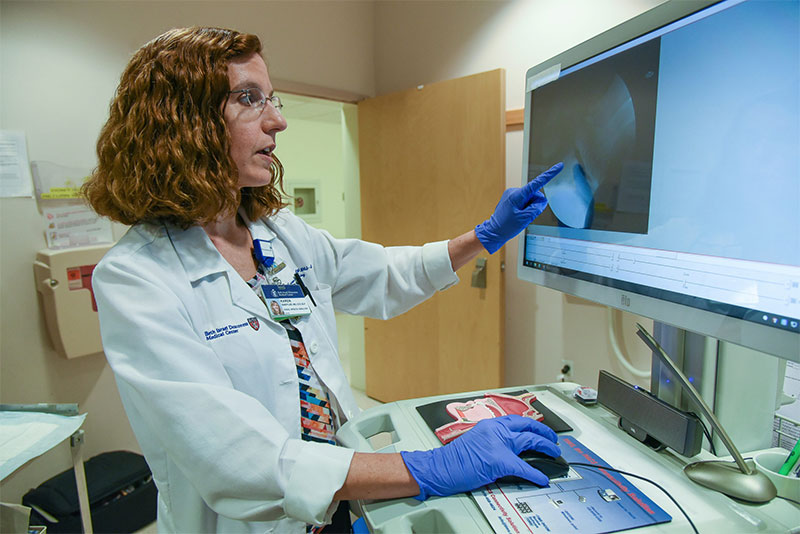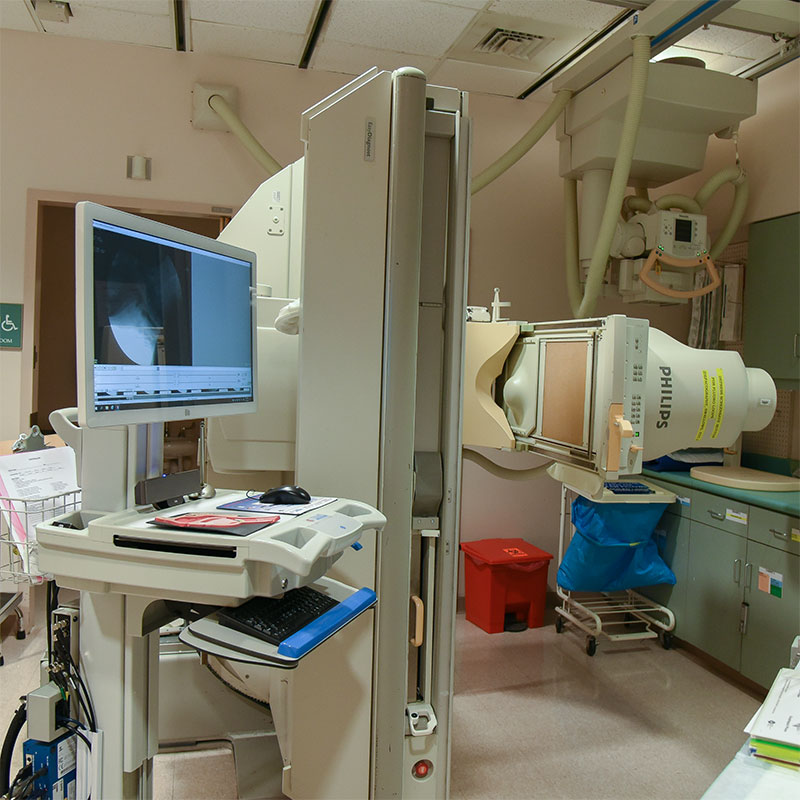Know the Facts:
What are the True Radiation Risks from
Videofluoroscopic SwallowStudy.com?
By Karen Sheffler, MS, CCC-SLP, BCS-S of SwallowStudy.com
in collaboration with Dr. Heather Shaw Bonilha, Ph.D., CCC-SLP
Are these common scenarios in your clinical day working with people who have difficulty swallowing (dysphagia)?
- Your patient refuses a medically and therapeutically necessary swallowing evaluation with motion x-ray (aka, Videofluoroscopic SwallowStudy.com/VFSS or Modified Barium SwallowStudy.com/MBSS) due to radiation risks from videofluoroscopic swallow studies.
- The doctor refuses to send your patient for a VFSS due to radiation risks and not understanding the benefits to the patient.
- Your radiologist stops your VFSS at less than 2 minutes and wants to use a pulse per second rate of 15 or less, rather than the standard of 30 pulses per second.
Therefore, you are not able to perform a complete and accurate examination.
Did you know that key laryngeal movements for airway closure may happen within 4 frames at a pulse per second rate of 30 pps (recorded at 30 frames per second/fps)? You must record and view images with at least 30 frames per second. Using a lower rate of 15 or less will also affect your ability to make safe and reasonable therapeutic recommendations.
At the 2019 Dysphagia Research Society annual meeting in San Diego, CA, Dr. Heather Shaw Bonilha presented her team’s very important published work (Bonilha, Huda, Wilmskoetter, Martin-Harris & Tipnis, 2019). Their study dispels myths and makes sure that we stop shortchanging our patients during their instrumental examinations for diagnosing dysphagia and planning treatment. Their research so far pertains to risks for adults.
Before we can discuss the risks and benefits of a VFSS/MBSS with our patients, we need to really understand the actual radiation risks from a fluoroscopic examination. This groundbreaking research, in collaboration with prominent Medical Physicists (Dr. Walter Huda and Dr. Sameer V. Tipnis), will change the way you talk about, advocate for, and perform the VFSS/MBSS.
Key Points Regarding the Low Radiation Risks from Videofluoroscopic SwallowStudy.com:
- The Videofluoroscopic SwallowStudy.com/Modified Barium SwallowStudy.com exposes adults to very low levels of radiation:
Total Median Effective Dose for Adults = 0.27 mSv (millisievert)
- Let’s put 0.27 mSv into perspective. 0.27 millisieverts is:
- Less than the amount emitted from your body in a year,
- About 32 days of natural background radiation living in the USA,
- A little more than a chest x-ray,
- Less than a mammogram,
- Far less than a head CT, and
- Far less than the allowed work-related effective dose limits of 50 mSv/year.
- See Personal Annual Radiation Dose Calculator.
- What does that mean for estimated cancer risks?
- The three organs that represented over 90% of the total cancer incidence risk were the thyroid, lungs, and red bone marrow.
- Cancer incidence risk for adults undergoing these studies are:
- 0.0011% for 20-year-old males
- 0.0032% for 20-year-old females
- 0.00049% for 60-year-old males
- 0.00072% for 60-year-old females
- Per Dr. Heather Shaw Bonilha:
“Overall, that is incredibly low and good news for us to be using this exam to fulfill our diagnostic and treatment needs for our patients.”
ALARA:
What We Do to Minimize Radiation Risks from Videofluoroscopic SwallowStudy.com:
We adhere to the ALARA principle (As Low As Reasonably Achievable), meaning we try to minimize radiation risks from videofluoroscopic swallow studies through many methods.
However, it is not reasonable to perform an exam at 15 pulses per second (pps), recording at 15 frames per second (fps), versus the industry standard of 30 pps or using continuous fluoroscopy. Dr. Bonilha’s prior research (Bonilha, et al., 2013) has already shown that an exam at 15 pps is not as accurate as one that is at 30 pps/fps. Her research showed that our analysis and ability to make important severity ratings about the pharynx and larynx were affected. Potentially dangerous differences were even seen in the treatment recommendations when clinicians used 15 pps/fps versus the standard of 30 pps/fps. Performing your VFSS at 15 pps can cause errors in selection of compensatory strategies, recommendations for therapeutic exercises, and recommendations for diet modifications.
During her DRS talk (March, 2019), Dr. Bonilha concluded:
“A pulse rate at 15 pps or lower reduces diagnostic accuracy to a degree that influences treatment recommendations; and therefore, it is NOT compliant with ALARA because that is not a reasonable decision.”
“We know that the cancer risks for adults undergoing VFSS/MBSS are so low that we really should not be compromising diagnostic accuracy to reduce radiation exposure.”
Advocate
She advised speech-language pathologists (SLPs) to take this 2019 publication and data to your patients, medical team and radiologists to advocate for the most thorough examination possible when it is clinically necessary. The clinical benefit to the patient outweighs these very low risks. It is not within ALARA guidelines to do such a poor-quality examination that it was of no clinical or practical benefit and has to be repeated. That is more radiation exposure to repeat the examination.
Standardized Protocols & Personalized Medicine
One way we already reduce radiation exposure during the VFSS/MBSS is by using a protocol to systematically test different foods, liquids, and a pill. However, in a personalized medicine approach (aka, “platinum-standard” rather than gold-standard), you do need to answer your specific questions (hypotheses) that you have about your patient. We may alter a standard protocol to customize it for an individual, including efficient trials of safer swallowing strategies.
We can also limit exposure by communicating with the radiologist before and during the study, telling her/him what we need to see and why. Tell the radiologist “flouro on” and “fluoro off” quickly to limit the time that the camera is on.
Do I Have to Stop the Exam at 2 Minutes of Fluoroscopy Time?
Bonilha also noted at DRS (March, 2019) that the fluoroscopy time is an arbitrary piece of data. Have you been limiting your examinations to only 2 minutes? Per Bonilha, the total time of the exam is not correlated with the actual radiation exposure.
- Do Not be overly worried about an examination over 3 minutes or even extending to 5 minutes, but
- Do ask yourself if every bite and sip contribute to the diagnostic and therapeutic goals for the individual. Make every trial count.
- Do test enough trials of a swallowing strategy to make sure it is actually reliably effective.
Summary on Radiation Risks from Videofluoroscopic SwallowStudy.com
The radiation risks from videofluoroscopic swallows studies are incredibly low!
It does not meet the ALARA principles if you are artificially limiting or ending the exam early for fear of radiation exposure. That would be radiation exposure without the clinical benefit of critical health information for the patient’s safety and quality of life.
Ask yourself during the examination: Does the person in front of you (and/or a caregiver) know what and how to safely eat and drink based on your findings and recommendations? Or, was your examination too brief to be of a functional benefit as she/he leaves the examination room?

Karen is using images after the study to educate her patient about his difficulty swallowing and what he can do about it. Photo Credit: Jennifer Cogswell 2019
Additionally, after the study, make sure to watch the examination in the slow-frame-by-frame mode, rather than making all judgements live. You have to record these examinations and watch them in detail after the study. The swallow is so fast! Your frame-by-frame analysis will tell you why the stuff went down the wrong way (i.e., penetration and aspiration, which are safety issues) and why the stuff got stuck (i.e., food, liquid and/or pill residue in the mouth and pharynx, stasis in the esophagus, and/or the material coming back up after the swallow. These are efficiency issues).
Finally, make sure to document these details well so that the next therapist can pick up your report and plan treatment from it. It certainly goes against ALARA principles if your report is so lacking that the study has to be repeated by the next treating therapist. Our exams and our reports should be full of clinically useful information to target exercises to the individual’s needs and wishes.
Dr. Bonilha stressed that this research applies to adults so far.
Bottom line per Dr. Bonilha:
“Don’t NOT use the exam for fear of radiation exposure!”
How is that for ending with a double-negative!
Resources & References:
Thank you to Dr. Heather Shaw Bonilha, Ph.D., CCC-SLP for our collaborations over the past year to educate clinicians, the healthcare community and the public about your team’s groundbreaking research. You can contact Dr. Bonilha at:
Bonilha, H.S., Huda, W., Wilmskoetter, J., Martin-Harris, B. & Tipnis, S.V. (2019). Radiation risks to adult patients undergoing modified barium swallow studies. Dysphagia, https://doi.org/10.1007/s00455-019-09993-w.
https://www.ncbi.nlm.nih.gov/pubmed/30830303
Bonilha, H. (2019, March). Real issues with VFSS: When is it useful? When is it harmful? Session presented at Dysphagia Research Society Annual Meeting, San Diego, CA.
Bonilha, H.S., Blair, J., Carnes, B., Huda, H., Humphries, K., McGrattan, K., Michel, Y., Martin-Harris, B. (2013). Preliminary Investigation of the Effect of Pulse Rate on Judgments of Swallowing Impairment and Treatment Recommendations, Dysphagia, 28(4), 528-538. https://doi.org/10.1007/s00455-013-9463-z
Personal Annual Radiation Dose Calculator:
https://www.nrc.gov/about-nrc/radiation/around-us/calculator.html



Do you mind if I quote a couple of your articles as long as I provide
credit and sources back to your website? My blog site is in the exact
same niche as yours and my visitors would definitely benefit from a lot of the information you
provide here. Please let me know if this ok with you.
Many thanks!
Sure, Just make sure to cite my name and the date and title of the post from SwallowStudy.com